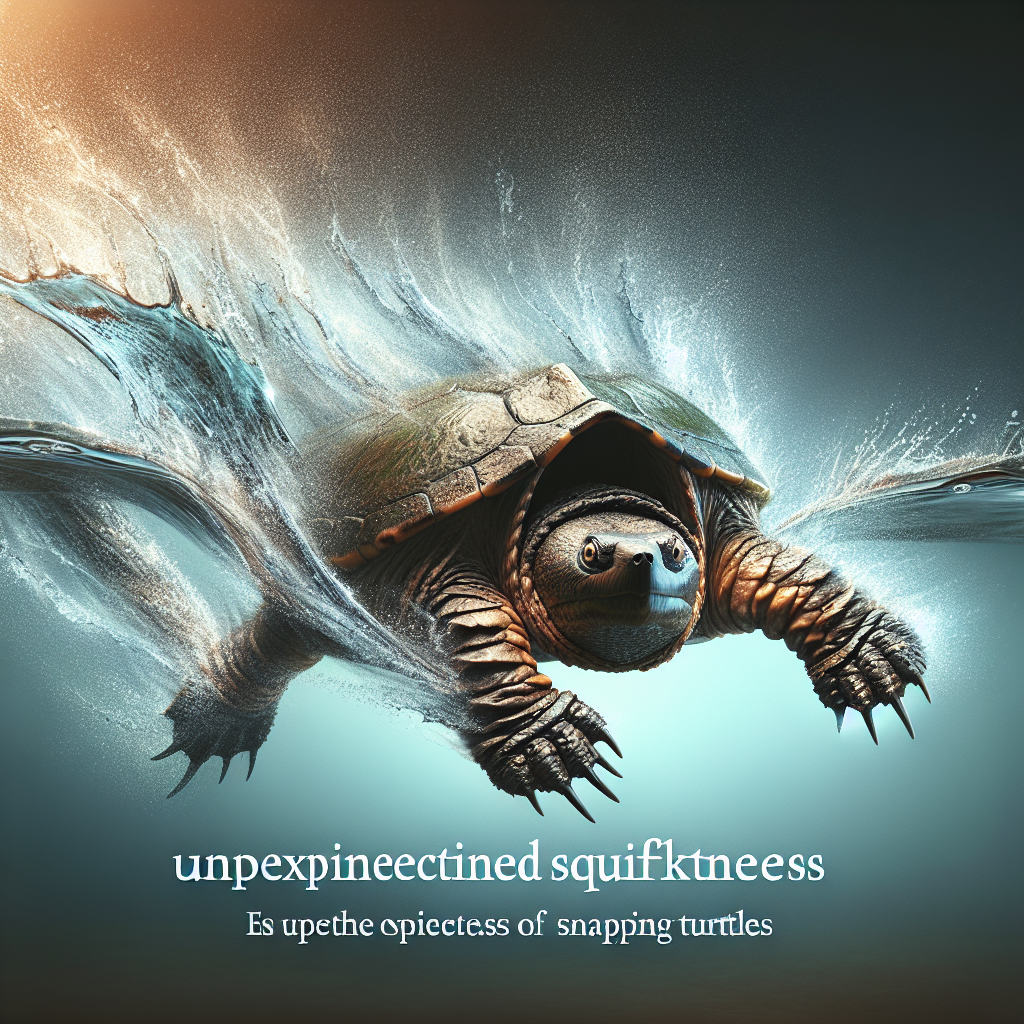Imagine you’re leisurely strolling by a tranquil pond, when suddenly you spot a mysterious creature lurking beneath the water’s surface. With a reputation for their powerful jaws and snappy temperament, snapping turtles have always piqued our curiosity. But have you ever wondered just how fast these ancient reptiles can move? In this article, we will uncover the surprising speed of snapping turtles and shed light on their incredible abilities to glide through both land and water. Hold on tight as we embark on a fascinating journey into the world of these fascinating creatures.
Anatomy of a Snapping Turtle
Shell
The shell of a snapping turtle is one of its most defining features and serves as its primary form of protection. Made up of two main parts, the carapace and the plastron, the shell is composed of bony plates covered in tough, keratinized skin. The carapace, the upper part of the shell, is typically dark brown or black and features a rough, textured surface. On the other hand, the plastron, the lower part of the shell, is lighter in color and is mostly flat. The shell is fused to the turtle’s spine and ribs, providing vital support and protection for its internal organs.
Head and Jaws
The head of a snapping turtle is large and triangular-shaped, with a prominent hooked beak-like snout. It is capable of extending and retracting, allowing the turtle to strike quickly at its prey. Snapping turtles have powerful jaws lined with sharp, pointed teeth, which they use to grab and tear apart their food. Their bite is incredibly strong, and they have been known to bite through various objects, including fishing lines and sticks. It’s important to exercise caution when handling a snapping turtle to avoid getting bitten.
Limbs and Tail
Snapping turtles have sturdy limbs equipped with sharp claws, which they use for digging, climbing, and grasping prey. Their front limbs are shorter and more muscular compared to their hind limbs, enabling them to efficiently navigate both land and water. The turtle’s tail is long and covered in scales, providing additional propulsion while swimming. The tail also serves as a defensive mechanism, as it can be used to deliver powerful strikes to potential threats. Snapping turtles are excellent swimmers and rely on their limbs and tail to maneuver through water with remarkable agility.
The Habitat of Snapping Turtles

Freshwater Turtles
As their name suggests, snapping turtles primarily inhabit freshwater environments such as ponds, swamps, lakes, and rivers. They can be found in both slow-moving and fast-flowing bodies of water, adapting to different aquatic habitats. These turtles are well-suited to living in freshwater thanks to their ability to extract oxygen from the water through their cloaca, a multi-purpose opening on the rear end of their body. Despite being primarily aquatic, snapping turtles also venture onto land for various activities such as basking and nesting.
Preferred Habitats
Snapping turtles have a preference for habitats that provide ample opportunities for feeding and basking. They are often found in areas with abundant aquatic vegetation, as it serves as a food source and provides cover for sneaking up on prey. Submerged logs or fallen trees are also ideal habitats, offering both shelter and a strategic vantage point for hunting. Snapping turtles tend to favor bodies of water with muddy or sandy bottoms, as these environments are rich in invertebrates and other small organisms that make up a significant portion of their diet.
Basking and Nesting Sites
Basking is a crucial activity for snapping turtles, as it allows them to regulate their body temperature and absorb essential UV rays. They are commonly seen perched on partially submerged logs or rocks, with their shells exposed to the sun. Apart from basking, these turtles also require suitable nesting sites for laying their eggs. Snapping turtles usually select areas with loose, well-drained soil close to water bodies for their nests. The female turtle digs a hole using her hind limbs and deposits her eggs before covering them back up and returning to the water.
Feeding Behavior of Snapping Turtles

Opportunistic Omnivores
Snapping turtles are opportunistic feeders, meaning they are not picky eaters and will consume a wide variety of prey and plant matter. They have a highly adaptable diet that includes both animal and plant material. In the water, snapping turtles feed on fish, frogs, tadpoles, snails, insects, and various aquatic plants. On land, they forage for earthworms, small mammals, birds, snakes, and carrion. This flexibility in their feeding behavior allows them to thrive in different habitats and take advantage of available food sources.
Favorite Prey
While snapping turtles have a diverse diet, certain prey items are particularly favored by these formidable reptiles. Small fish, especially slow-moving species, are a preferred target due to their abundance in aquatic environments. Snapping turtles also have a fondness for amphibians such as frogs and tadpoles, which can be easily caught while they swim or bask in the sun. Additionally, they have been known to actively hunt larger prey such as waterfowl and small mammals when the opportunity arises.
Hunting Techniques
Snapping turtles rely on an ambush-style hunting technique to catch their prey. They can remain motionless for extended periods, patiently waiting for unsuspecting prey to venture close. When a potential meal comes within striking distance, the snapping turtle strikes with lightning-fast speed, extending its head and jaws to capture the prey. Their powerful bite quickly incapacitates their target, allowing them to consume it or drag it underwater to consume at their leisure. Snapping turtles are efficient hunters, often seizing the opportunity to capture prey that gets too close to their vicinity.
Reproduction and Mating Habits

Mating Rituals
Snapping turtles have a unique and fascinating mating ritual that typically takes place in shallow water during the spring or early summer. Male snapping turtles use their long claws and powerful limbs to engage in combat with other males, competing for the attention of a female. They often engage in “face-offs,” attempting to push each other into submission. Once a male successfully establishes his dominance, he will approach the female and attempt to court her by stroking her head and shell with his forelimbs. If the female is receptive, mating occurs underwater.
Nesting and Hatching
After mating, the female snapping turtle seeks out a suitable nesting site on land, away from the water. Using her hind limbs, she excavates a hole in the soil where she lays her eggs. The number of eggs laid varies, but it can range from around 20 to 50 eggs per clutch. After laying her eggs, the female carefully covers them up with soil and leaves them to develop and hatch on their own. The incubation period typically lasts between 70 to 90 days, with the young snapping turtles emerging from the nest and making their way to the nearest body of water.
Sexual Dimorphism
Sexual dimorphism refers to the physical differences between male and female individuals of the same species. In the case of snapping turtles, males are generally smaller than females, with longer tails and thicker claws. Females, on the other hand, have larger bodies and jaws, as well as shorter tails and smaller claws. These differences are typically more pronounced in older individuals. Sexual dimorphism is an important characteristic in snapping turtles and helps differentiate between the males and females.
Lifespan and Size of Snapping Turtles

Longevity
Snapping turtles are known for their impressive lifespan, with some individuals living for over 50 years in the wild. However, their longevity can vary depending on several factors, including the availability of food, habitat quality, predation, and human impacts. Snapping turtles have a slow growth rate, and it takes many years for them to reach sexual maturity. Once they reach adulthood, they tend to experience lower mortality rates, resulting in their long lifespans.
Size Variation
Snapping turtles exhibit significant size variation, with males generally being smaller than females. On average, adult snapping turtles measure between 8 to 14 inches in length, excluding their tail. However, some individuals can grow much larger, with some females exceeding 18 inches in length and weighing over 35 pounds. The size of snapping turtles is influenced by various factors, including genetics, nutrition, and environmental conditions during their growth and development stages.
Growth Rate
Snapping turtles have a slow growth rate compared to many other reptiles. It takes several years for them to reach sexual maturity, with males typically maturing around the age of 8 to 12 years, while females may take longer, around 10 to 15 years. The growth rate of snapping turtles is influenced by external factors such as food availability and climatic conditions. Adequate nutrition and favorable environmental conditions can contribute to faster growth rates, allowing the turtles to reach maturity sooner.
Predators and Threats to Snapping Turtles

Natural Predators
Snapping turtles, despite their size and powerful jaws, have some natural predators that pose a threat to them at various stages of their life. As hatchlings, they are most vulnerable and often fall prey to larger fish, birds, raccoons, skunks, and other mammals. As they grow older and larger, their size serves as a deterrent to many predators. However, adult snapping turtles still face threats from larger predators such as alligators, some large birds of prey, and occasionally, even from other snapping turtles.
Human Activities
Human activities have a significant impact on snapping turtle populations. Habitat destruction due to urbanization, pollution of water bodies, and the loss of suitable nesting sites all pose threats to these turtles’ survival. Snapping turtles are also harmed by accidental entanglement in fishing gear, vehicular collisions during nesting migration, and even intentional harm caused by humans. It’s crucial for humans to be mindful of their actions and take measures to conserve these fascinating reptiles and their habitats.
Conservation Status
The conservation status of snapping turtles varies among different species and populations. Some species, such as the alligator snapping turtle, are classified as threatened or endangered due to habitat loss and overexploitation. Other species, like the common snapping turtle, are more widespread and not currently considered globally threatened. However, it’s important to note that populations of snapping turtles have faced significant declines in many regions, emphasizing the need for conservation efforts and the protection of their habitats.
Snapping Turtle Species
Common Snapping Turtle
The common snapping turtle (Chelydra serpentina) is one of the most widespread and well-known species of snapping turtles. Found throughout North America, from southern Canada to Florida, these turtles inhabit a variety of freshwater environments. They are characterized by their powerful jaws, rugged appearance, and the ability to adapt to various habitats. The common snapping turtle is an important part of the ecosystem, serving as both predator and scavenger and playing a vital role in maintaining the ecological balance.
Alligator Snapping Turtle
The alligator snapping turtle (Macrochelys temminckii) is the largest freshwater turtle species in North America. Endemic to the southeastern United States, these turtles are known for their massive size, powerful jaws, and distinctive appearance. They have a prehistoric look, with a spiked shell and a worm-like lure on the tongue used to attract prey. Due to habitat destruction and overharvesting, the alligator snapping turtle is now considered a threatened species, highlighting the urgent need for conservation efforts to protect this unique and ancient reptile.
Other Species
Apart from the common and alligator snapping turtles, several other species of snapping turtles exist. Some notable examples include the Florida snapping turtle (Macrochelys suwanniensis), the Ouachita snapping turtle (Macrochelys ouachitensis), and the Mexican snapping turtle (Chelydra rossignonii). Each species has its own unique characteristics, distribution, and conservation status, adding to the diversity and ecological importance of snapping turtles globally.
Snapping Turtles and Humans
Interaction with Humans
Snapping turtles have a complex relationship with humans. While they are generally shy and prefer to avoid human contact, encounters can occur in various scenarios. Snapping turtles may be observed while basking near shorelines or when crossing roads during nesting migrations. It’s important to give snapping turtles ample space and avoid disturbing or handling them, as they may perceive humans as threats and respond defensively by snapping or biting. Observing these incredible creatures from a safe distance allows for a mutually respectful coexistence.
Keeping Snapping Turtles as Pets
Keeping snapping turtles as pets requires careful consideration and responsible ownership. These turtles have specific habitat and dietary requirements that must be met to ensure their well-being. Adequate space, a suitable filtration system for their tank, a varied diet, and appropriate UV lighting are essential for their health. It’s important to note that snapping turtles can grow quite large and require a significant commitment in terms of time, space, and resources. Potential pet owners should thoroughly research the species and consult with experts before deciding to keep a snapping turtle.
Conservation Efforts
Recognizing the importance of protecting snapping turtles and their habitats, conservation efforts are being implemented worldwide. These efforts include creating protected areas, managing nesting sites, promoting responsible fishing practices, and educating the public about the significance of these unique reptiles. Public participation in citizen science projects, reporting turtle sightings, and supporting organizations dedicated to the conservation of snapping turtles can also contribute to their long-term survival. By working together, we can ensure the preservation of snapping turtle populations for future generations to enjoy.
Swimming Abilities of Snapping Turtles
Adaptations for Aquatic Life
Snapping turtles are well-adapted for life in the water, with several physical characteristics that enhance their swimming abilities. Their streamlined bodies, strong limbs, and webbed feet allow for efficient propulsion through the water. The shape and texture of their shells contribute to their hydrodynamic design, minimizing drag as they swim. Snapping turtles also possess powerful respiratory systems that enable them to extract oxygen from the water, providing them with the necessary energy to swim and navigate their aquatic environments.
Speed in Water
While not known for their exceptional speed, snapping turtles are surprisingly agile swimmers. They are capable of propelling themselves through the water using their strong limbs and tail. When swimming at their maximum speed, snapping turtles can reach around 3 to 4 miles per hour. While this may not be as fast as other aquatic species, such as turtles that rely on speed for prey capture, snapping turtles’ swimming abilities are more than sufficient for their hunting and survival needs.
Factors Affecting Swimming Speed
Several factors can influence the swimming speed of snapping turtles. These factors include the turtle’s size, health, and physical condition, as well as the water temperature and current. Larger snapping turtles tend to have more mass to propel through the water, which may slightly reduce their speed compared to smaller individuals. Additionally, cooler water temperatures can affect the turtles’ metabolism and overall activity level, potentially impacting their swimming speed. Despite these factors, snapping turtles are generally adept swimmers, able to navigate their aquatic habitats with ease.
Snapping Turtles on Land
Locomotion on Land
Despite being primarily aquatic, snapping turtles are also capable of moving on land. Their limbs are well-suited for terrestrial locomotion, allowing them to crawl and walk across various surfaces. While not as agile on land as they are in water, snapping turtles can still cover significant distances when necessary, especially during nesting season or when seeking new habitats. Their ability to move on land is aided by their strong claws and muscular limbs, which provide the necessary support and traction on different types of terrain.
Walking and Trotting Speed
When on land, snapping turtles typically exhibit a slow and deliberate walking motion. Their short, sturdy limbs and domed shell can make walking a bit laborious, resulting in the characteristic slow pace associated with these turtles. On average, snapping turtles can walk at a speed of around 0.5 to 1 mile per hour. However, when startled or threatened, snapping turtles may break into a surprisingly brisk trot, covering short distances at a significantly faster pace. This increased speed is a temporary burst of energy used to escape potential dangers.
Challenges on Land
While snapping turtles can navigate on land, they face several challenges outside their natural aquatic habitat. Their large, cumbersome shells can make maneuvering over obstacles such as rocks, fallen branches, or uneven terrain more challenging. Additionally, the lack of water can pose risks to their overall health and well-being. Snapping turtles require adequate hydration and moist environments to prevent dehydration and maintain their skin’s health. Therefore, it is crucial for humans to avoid unnecessary disturbance or disruption of snapping turtles when they are on land, allowing them to safely return to the water where they are most comfortable.
In conclusion, snapping turtles are fascinating reptiles with unique anatomical features, diverse habitats, and intriguing behaviors. Their shells, heads, and limbs are specifically adapted for their aquatic and terrestrial lifestyles. Snapping turtles are opportunistic omnivores, feeding on a wide variety of prey and vegetation. Their mating rituals, nesting habits, and sexual dimorphism contribute to their reproductive success. With their impressive lifespan, size variation, and slow growth rate, snapping turtles are remarkable creatures that play important roles in the ecosystems they inhabit. While they face threats from natural predators, human activities, and habitat loss, conservation efforts aim to protect and preserve these captivating reptiles. By understanding and appreciating the anatomy, habitats, feeding behavior, reproduction, lifespan, and interaction of snapping turtles with humans, we can foster a greater sense of respect and conservation for these remarkable creatures.
